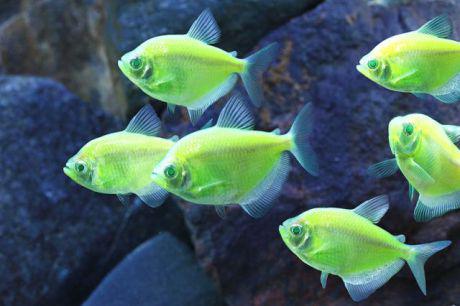Over the past decade fish that glow neon under a black light have become
increasingly popular in aquariums. GloFish were created by Yorktown Technologies in 2003 by
adding genetic material from fluorescent coral to zebra fish. Since
then the genetically modified fish have been sold by the millions in a
 Electric Green Tetra (Photo by WWW.GloFish.com/Creative Commons via Wikimedia)rainbow of brilliant colors. Earlier this year they unveiled their
latest creation: the Electric Green Tetra. The problem is the concern these
fish will start
showing up in open waterways as so many other aquarium species have and their subsequent
impact on native species.
Electric Green Tetra (Photo by WWW.GloFish.com/Creative Commons via Wikimedia)rainbow of brilliant colors. Earlier this year they unveiled their
latest creation: the Electric Green Tetra. The problem is the concern these
fish will start
showing up in open waterways as so many other aquarium species have and their subsequent
impact on native species.
The Electric Green Tetra is a genetically modified black tetra and is the one of the two fish that is creating the greater amount of concern to the United States due to the fact that they are capable of living in freshwater and able to withstand colder water temps than their zebra cousins. The black tetra is from South America and would be most at home along the inter-coastal waterways in Florida. South Florida is already dealing with more than 30 species of non-native fish.
The controversy lies between scientists who say that the fish could mate with native fish creating weaker hybrids. Other scientists claim that there is no evidence that this would be the case. Some say that if the green tetras mate with black tetras, then the genetically modified traits would vanish in a few generations of the fish, while other scientists disagree that this would be the case.
While black tetras have been found in Florida's waterways, there is no evidence of them being reproducing populations. Experts believe that they are eaten by larger fish. In one experiment the neon zebra GloFish were placed in a tank with large-mouthed bass and mosquito fish. The predator fish were more likely to eat the bright red zebra fish.
What neither side mentioned is what might happen as these genetically modified fish make their way into wild-caught fresh fish in our food supply other than to say that there is not a clear risk. Genetically modified fish are not allowed in Canada and much or Europe, and cannot be sold in California.
The controversy over Genetically Modified Organisms has already been raging for years as companies have been introducing them into food crops.
Source: Washington Post

